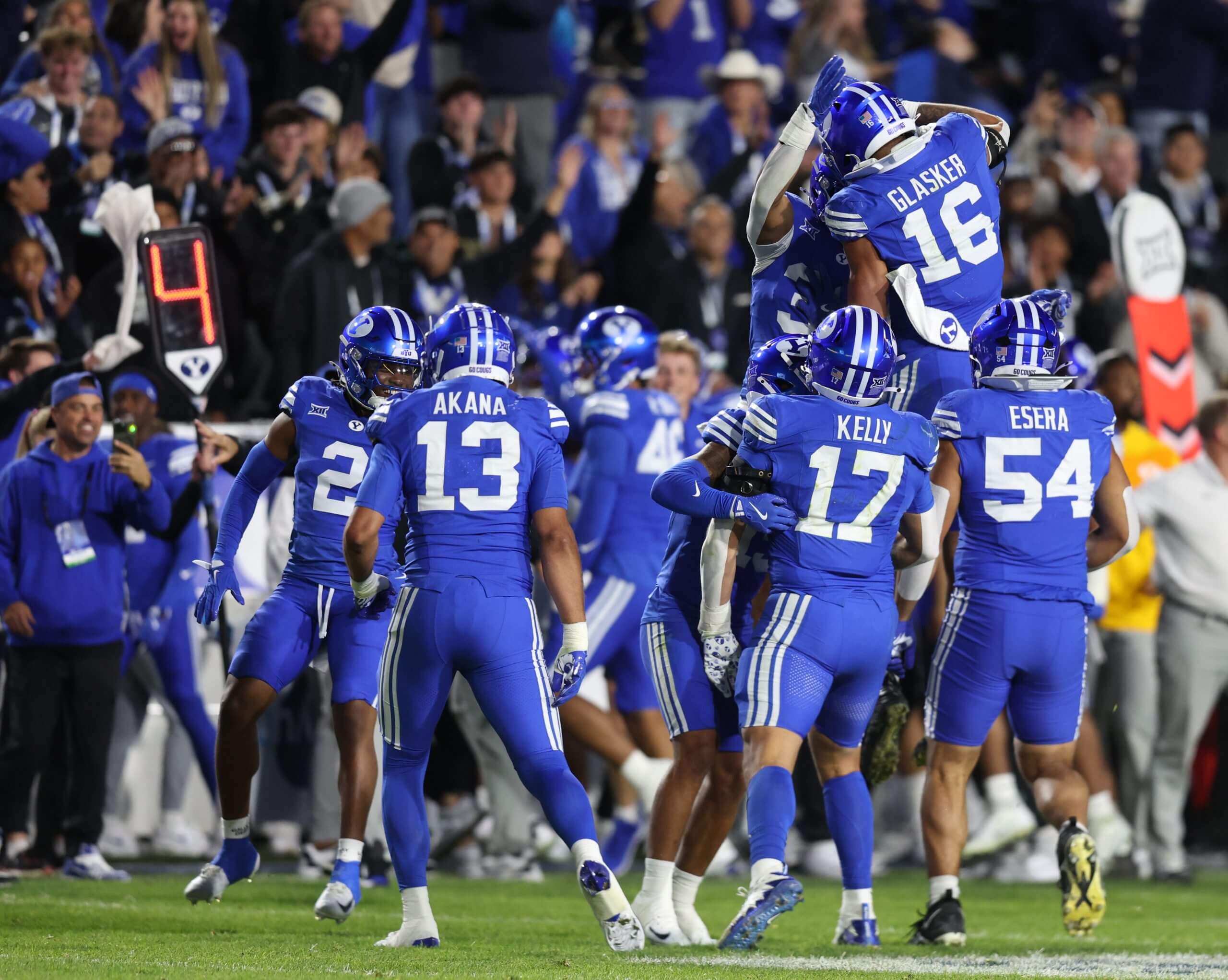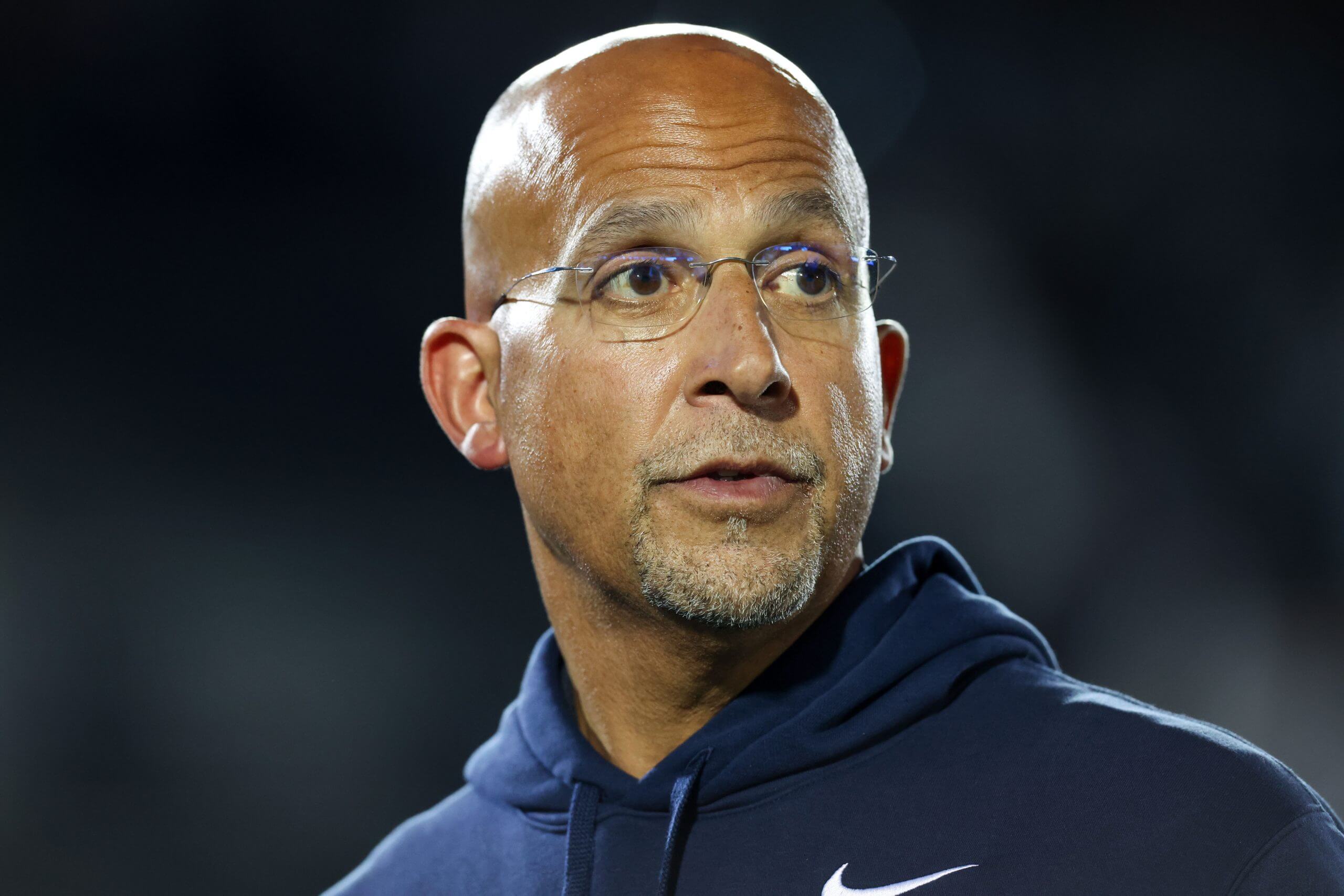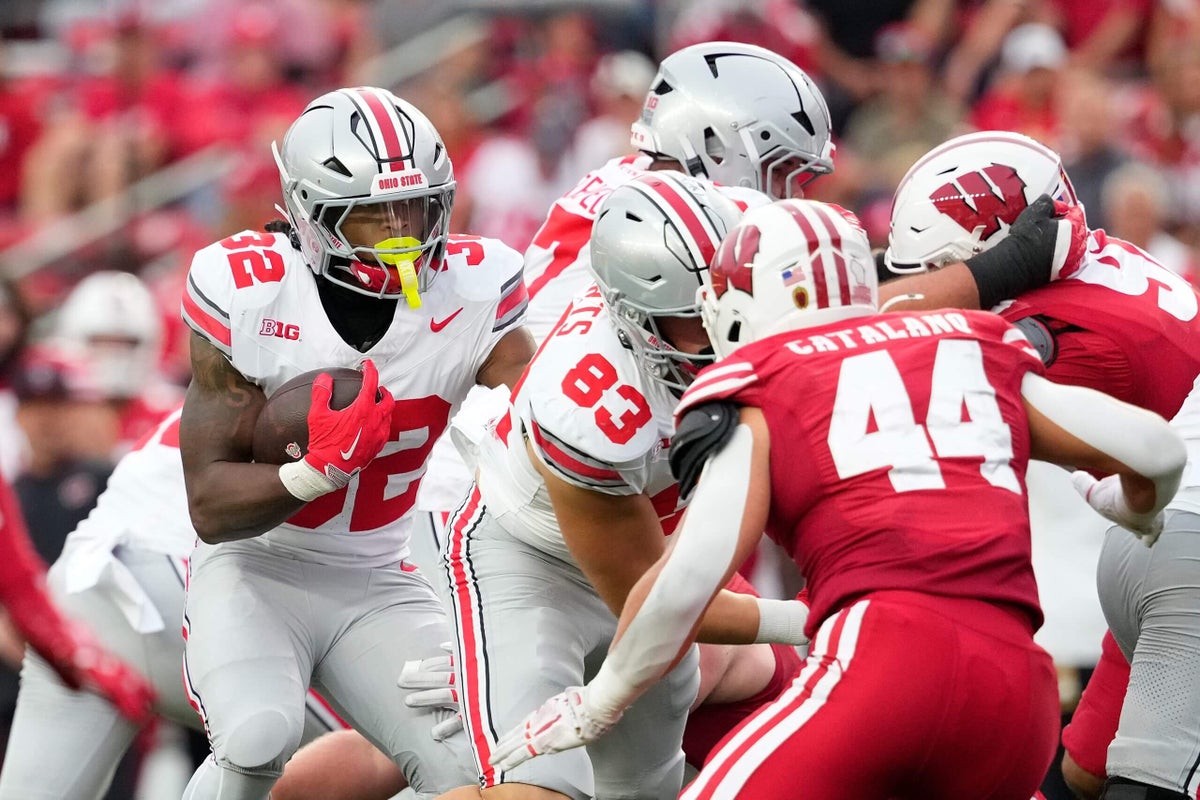I’ve got to say, this has been one of the newsiest seasons I can remember covering. It’s not enough just to watch and write about the games; you’ve also got to stay on top of coaches getting fired after a win, not fired after a bad loss, private equity deals and GMs going to Saudi Arabia — and, of course, tortilla controversies.
We’ll get to that last one later.
Of the 44 first- and second-teamers currently at Ohio State, I only count eight seniors scattered among both levels. So, if they win the national championship again this year, would they also start the 2026 season as the favorite? — Charles C.
Yes, because Ohio State would be back-to-back national champions at that point, and no one would dare vote for anyone else, possibly for several years. But before we go ahead and fast-forward to August 2026, I’d like to take this opportunity to slow everybody’s roll about the 2025 Buckeyes.
Ohio State is the unquestioned No. 1 team right now, with good reason. Ryan Day’s team has been dominant. I’m not going to suggest it’s a fraud, or even that I’ve detected some vulnerability. But has anyone stopped to look at what’s become of its schedule?
The accolades began when the Buckeyes’ defense humiliated Texas and Arch Manning, but since then, everyone from UTEP to Florida to Kentucky has done the same. Illinois was their other Top 25 win, but the Illini have been overvalued by the pollsters all season. They are No. 31 in ESPN’s SP+ ratings and No. 38 in Austin Mock’s College Football Playoff odds while boasting the nation’s No. 79 defense in yards per play. Minnesota, which Ohio State beat 42-3 in Columbus, is closer to No. 50 than No. 25 in the power ratings. And Wisconsin might be worst team in the Big Ten.
Ohio State’s most impressive performance remains its 24-6 win at Washington on Sept. 27 when the Buckeyes held a top-20 Huskies offense to 234 yards. That was the game when I said that defense is special. I still feel that way. But even that win got a bit devalued when Michigan also shut down Washington last week, a 24-7 win in Ann Arbor. And now, what we all assumed would be Ohio State’s second-biggest conference game, Nov. 1 versus Penn State, has been reduced to rubble as well. We won’t see the Buckeyes get tested again before The Game.
Now let’s compare those first seven games with those of the teams ranked Nos. 2-5. No. 2 Indiana won a top-10 game at Oregon, No. 3 Texas A&M beat current No. 12 Notre Dame on the road, No. 4 Alabama has beaten four straight Top 25 teams and No. 5 Georgia just beat a then-top-5 Ole Miss team. All of those teams have looked flawed at times as well — IU escaped at Iowa, Bama lost at 3-4 Florida State, A&M gave up 42 points to Arkansas and Georgia’s defense is brutal — but that’s more likely to happen when you’re playing a tougher schedule.
I’ve seen some people say this week that Alabama and Ohio State are on a collision course for the national championship game, which seems waaaay premature. The Tide are hot, but we already know they’re vulnerable. And though the Buckeyes have not been touched, I’d just caution people to look back at some past Ohio State teams — 2006, 2013 and 2022 come to mind — that went undefeated for the first 11-12 games only for us to find out that, like most college football teams, they weren’t unbeatable after all.
Plus, the national championship game is obviously going to be Indiana vs. Vanderbilt.
Stew, in your last column, you wrote the following: “Unlike the ACC, where Miami and Georgia Tech have realistic at-large chances, the Big 12 looks very much like a one-bid league again due to the teams’ lack of big nonconference wins.” Can you unpack why Georgia Tech can get an at-large bid but BYU can’t, assuming an equal number of losses? — David P.
You could certainly make the case that, as of today, BYU has a better resume than Georgia Tech. The Cougars were actually receiving more AP votes for the first three weeks, but the Jackets lapped them after they beat then-No. 12 Clemson. That win is completely devalued now, with the Tigers at 3-4, but the voters never felt compelled to reorder them. No. 11 BYU’s win over 5-2 Utah last weekend easily trumps anything on No. 7 Georgia Tech’s resume.
But Haynes King and company have an opportunity at the end of the regular season that BYU doesn’t: beat current No. 5 Georgia. If Tech either misses or loses the ACC championship game but has 11 wins, and one of them is against the Dawgs, it’s getting an at-large berth, no questions asked. The Cougars might have an at-large path as well, given they could pick up Top 25 road wins at either current No. 14 Texas Tech or current No. 21 Cincinnati, but I wouldn’t feel great about it because we saw how the committee thinks of the Big 12 last season when it ranked its champion 12th.

BYU is one of six remaining undefeated FBS teams but ranked just No. 11 in the AP poll. (Rob Gray / Imagn Images)
And all of that same at-large rationale applies to Miami, which has the Notre Dame and USF wins in its back pocket to counter what might wind up being an unimpressive conference resume.
It would behoove Big 12 schools to try to schedule a Big Ten or SEC opponent every year to help their CFP chances. But I realize that’s only getting more difficult with the SEC going to nine conference games. Already, we’ve seen Alabama cancel a home-and-home series with West Virginia and Florida cancel one with Arizona State.
There is a possible solution, but Big 12 fans might not like it: Start scheduling one-off road games (I’ll spare them the phrase “guarantee game”) at respected Big Ten and SEC schools. They might be more likely to sign on if they don’t have to give up a home game. It’s not ideal, but that’s where we are in this sport. Playing Portland State, Stanford and East Carolina does nothing to help BYU’s Playoff chances.
Two years ago, we would have all agreed that Vanderbilt and Indiana were among the toughest places to build a winning program. Now that they are winning, which P4 programs would you list as being impossible to win big at? Or have the changes in college football made it such that the right coach, athletic director and donors can win anywhere? — Michael M.
I suppose that depends on what your bar is for “win big” and whether we’re talking a one-off or long, sustainable success. But the fact the Big Ten’s all-time losingest program is probably going to make back-to-back Playoffs and the SEC’s all-time losingest program is a realistic contender tells me you can win pretty much anywhere.
Some might say that’s been the case for some time. Wake Forest, the all-time losingest Power 4 program, went to seven straight bowls under Dave Clawson and was in the ACC championship game in 2021. Iowa State, the Big 12’s all-time losingest program in terms of win-loss record, went to the 2020 and 2024 Big 12 championship games. Kentucky was winning double-digit games under Mark Stoops not long ago, and Northwestern was in the 2018 and 2020 Big Ten title games.
What’s changed, though, is the Playoff. The fans of those programs have long been conditioned to feel like winning just six games is a successful season. Now, they, like everyone else, are completely justified in expecting 12/16/28-team Playoff contention. Not every year, obviously, but every few years. It might require a level of investment they’ve not previously made, but is by no means unattainable. Indiana and Vandy are playing ball in name, image and likeness, but their payroll is more Milwaukee Brewers than Los Angeles Dodgers.
Of course, there might be a few exceptions. Though I wouldn’t call any job “impossible,” Stanford’s has become significantly harder in the time since Jim Harbaugh and David Shaw were putting out top-10 teams. They were already fishing from a smaller pool of talent, and now that talent expects nice NIL deals and can leave at any time. And though every Group of 5 team in the country now plays for an automatic CFP berth, a lot of those MAC/Conference USA/Sun Belt programs would have trouble making the FCS playoffs, much less the CFP.
And Rutgers. Poor Rutgers. Just when you think it’s finally building some momentum under Greg Schiano, it has the worst defense in the entire FBS. I retract my earlier statement. This might be the one impossible job.
Everyone is ranking the destinations and potential candidates for the open coaching jobs (and some that aren’t open yet). Can you rank the fired coaches based on who has the best profile and best chances to land a decent job after being fired? — Joseph Y.
The fired coaches power rankings? Sure. I’m listing their ages because, right or wrong, that’s a factor in this biz.
1. James Franklin (53). Though he’s unlikely to land at another elite program, next-level-down Power 4 programs should be interested in a guy who was in the CFP semifinals just last year. UCLA, Stanford and Virginia Tech come to mind. He’d be better off waiting a year, when the way things ended at Penn State isn’t so fresh. But that didn’t sound like the plan on “College GameDay.”

James Franklin finished with a 104-45 record at Penn State. (Matthew O’Haren / Imagn Images)
2. Pat Fitzgerald (50). Fitz is highly respected in his profession, and his lawsuit against Northwestern is behind him. But he did go 3-9 and 1-11 in his last two seasons. A Penn State or Wisconsin would have trouble spinning that, but I could see him being perfectly happy in the American, or even as an FCS head coach.
3. Mike Gundy (58). The guy is admittedly not for everyone, but he has a heck of a track record. And will drive attention to an off-the-grid program. Looking at you, Oregon State and Colorado State. Or others like them that come open.
4. Billy Napier (46). The same things that made him attractive to Florida — Nick Saban and Dabo Swinney ties, 40-12 run at Louisiana — should help him find a soft landing as a Group of 5 head coach, perhaps back in the Sun Belt.
5. Sam Pittman (63). I’d put him into a similar bucket as Dan Mullen and Barry Odom, who got fired in the SEC, then resurrected themselves elsewhere, except Pittman is 10-15 years older than those guys, which might limit his options.
6. Brent Pry (55). I assume Pry will be a major program’s defensive coordinator next season.
7. Jay Norvell (62). The guy took Nevada to four straight bowls and was 8-5 at Colorado State just last season. He’ll either be a college offensive coordinator or perhaps an NFL assistant.
8. Troy Taylor (57). Getting fired at Stanford over hostile workplace allegations might make him too toxic to be a head coach again, but there’s much less scrutiny over an offensive coordinator.
9. DeShaun Foster (45). His brief UCLA head-coaching tenure did not go well and probably hurt his stock quite a bit. But he’s young and was well respected as a position coach. He’ll get a good assistant job.
10. Trent Dilfer (53). Maybe Lipscomb Academy will take him back.
11. Kenni Burns (41). Not only did he go 1-23 at Kent State, but also he got fired for taking out a six-figure loan that likely violated state ethics rules, racking up $16,000 in “questionable expenses,” and was sued by a bank over unpaid credit card debt.
Not even Jimmy Sexton could sell a candidate with that resume.
It’s just a harmless tortilla, joyfully tossed. Now it is banned. Why? Really?!? — Jim S.
Technically, the Big 12 did not ban them; instead, it created severe repercussions (15-yard penalties, $100,000 fine) that left Texas Tech no choice but to tell its fans to stop. (We’ll see whether they do.)
Look, I love silly college football traditions as much as anyone — but this one was a complete own-goal by Texas Tech. First, athletic director Kirby Hocutt goes and eggs on the fans before the season, all but assuring that more people will toss tortillas than before, and naively believes fans will listen to him and refrain from throwing them after the opening kickoff. Then the fans go and do it on the road, at Houston, so the people there have to clean up their mess. And then there was the fiasco against Kansas, when they just kept drawing penalties, and Lance Leipold got ticked.
So, the Big 12 had to take their toys away.
All that being said, they’ve been doing this at Texas Tech for more than 30 years. It does not seem like a coincidence that Big 12 schools only got offended by it once Tech started outbidding all of them for players.
Why should tortillas be banned from Texas Tech games? They have never hurt anyone, it’s nearly impossible to get a tortilla all the way to the main part of the field, they don’t make a mess when they hit the ground, and now local pigs won’t get the tossed tortillas, possibly causing piglets to go hungry. This rule makes absolutely no sense. — Robert P.
OK, I had no idea they were feeding them to the pigs. That changes my whole perspective on this.
Explain yourself, Brett Yormark.
It’s been a crazy, chaotic season so far. What/who has been the most interesting storyline: Arch, Penn State, Bill Belichick and Jordon Hudson, officiating at Auburn games, Indiana, tortillas, parity or something else? — Joel
This question makes me appreciate how truly blessed I am to cover college football.
Like many of you, trainwreck stories interest me more than rags-to-riches stories, officiating debacles or tortilla controversies, and there have been so many to choose from this season. But I’m finding I can’t get enough Belichick/UNC drama.
I’m not sure I’ve ever worked on a story quite like the “What’s gone wrong” piece that several colleagues and I reported on two weeks ago. Usually, if you reach out to two dozen people — many of whom none of us had ever spoken to — in search of interesting behind-the-scenes details, you’ll inevitably run into quite a few who either aren’t willing to talk to you or don’t add anything you hadn’t already heard. But this was the rare case when 1. Everyone wanted to talk and 2. Each person had a wilder, I-can’t-believe-this-is-real story than the last person.
And then the next week, after we’d published, we find out about Michael Lombardi’s fundraising trip to Saudi Arabia. I’m sure there will be another jaw-dropper next week.
I’ve been so fascinated, in fact, that I drove the hour and forty minutes or so (in traffic) to Berkeley on Friday night to see the Tar Heels take on Cal in front of a half-full stadium in what felt like the middle of the night. I got there early and went down to the sideline before the game, turned right and, lo and behold, there’s Jordon. Impossible to miss in her snakeskin jacket and knee-high cowboy boots, while surrounded by UNC friends/family wearing mostly jerseys/sweatshirts. Not going to lie: I was way more starstruck by her than by Bill, whom I’d also never seen in person.
None of which is to undersell James Franklin’s abrupt downfall, the humbling of Arch Manning, all those early-season coach firings, etc. But I’ve seen versions of those stories before. I’ve never seen anything like the Belichick fiasco.
If you were in a minor fender bender, which Allstate customer would you be most and least excited to exchange insurance information with: the Georgia fan who barked at work, the Michigan fan who stole cotton candy from a child, or the Texas fan who let the mascot out of his pen? — Kevin J.
I think I’d be scared of the Texas fan who seems wildly reckless and super-annoyed by the super-annoying Dawgs guy. But the cotton candy Michigan fan seems harmless. And funny.
Sidenote: Is anyone else surprised Michigan granted the use of its branding for a commercial about stealing?
